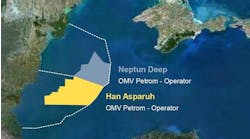Offshore staff
STAVANGER, Norway – Emerson, in cooperation with Statoil, has completed its Total Uncertainty Management program.
In October 2012, Emerson announced it would team up with Statoil for the program, which focuses on how E&P companies can improve history matching, uncertainty management, and quantification across the entirereservoir characterization workflow through Roxar Tempest ENABLE, Emerson’s history matching and uncertainty estimation software solution.
Emerson has delivered major updates to Tempest ENABLE following technical input from Statoil and the two companies have successfully completed the Total Uncertainty Management program. An incremental delivery approach was taken.
In 3Q 2014, the concept of Ensembles was introduced, which is said to improve statistical accuracy compared with traditional P10, P50, P90 approaches. In 2Q 2016, the Roxar Application Connector was introduced, designed to allow for chained workflows, and in 4Q 2016 the Ensemble Smoother was implemented. With the recent commercial 8.0 release ofRoxar Tempest, the benefits of the program are available to the industry.
The program’s enhancements to Tempest ENABLE, combined with the uncertainty management capabilities of Emerson’s Roxar RMS characterization and reservoir modeling software, allows workflows based on commercial software applications to quantify uncertainties across the complete reservoir characterization and development workflow. By analyzing multiple plausible realizations and incorporating the data into their decision-making, E&P companies can better quantify the effects of uncertainties on volumes and cumulative production so they can improve risk management.
Key elements of the Total Uncertainty Management program, which took place over four years, included:
• Further improvements to the “proxy” based history matching technique behind Tempest ENABLE, based on research and field trials by Statoil. Proxy based history matching and uncertainty has been shown to be a very effective means of using historical data to reduce the uncertainty of production forecasts.
• The implementation of Statoil’s innovative algorithms in Ensemble Smoother-type history matching and uncertainty. The Ensemble Smoother is a powerful history matching technique, particularly successful in handling the production effects seen on 4D seismic.
• A continued focus on integrated workflows between geological modeling, simulation, the forward modeling of seismic and history matching – a workflow common to both proxy based and Ensemble Smoother type methods.
• Maximizing the use of cluster and cloud computing within history matching and uncertainty management – essential for high volume and integrated workflows.
Kjetil Fagervik, VP Product Development and Marketing of Roxar Software Solutions,Emerson Automation Solutions, said: “Whether it be as input to field development and operational plans, investment proposals, or a future divestment, the ability to accurately generate future production estimates, quantify uncertainty, and minimize financial risk is one of the industry’s greatest challenges.”
Tempest ENABLE can be used at any stage of a field’s life, from bid appraisal to abandonment, and whether production data is available or not, Emerson said.
Roxar Tempest, which runs on Windows and Linux and operates alongside Emerson’s characterization and reservoir modeling solution, Roxar RMS, is an integrated software suite that provides a single interface.
Tempest MORE and Tempest VIEW, other modules are Tempest PVTx, a fluid analysis tool, and Tempest VENTURE, an economic evaluation tool that provides cash flow analysis derived from simulation results. All modules can be deployed as an integrated suite with a common interface, or separately within 3rd party simulation workflows.
05/26/2017


